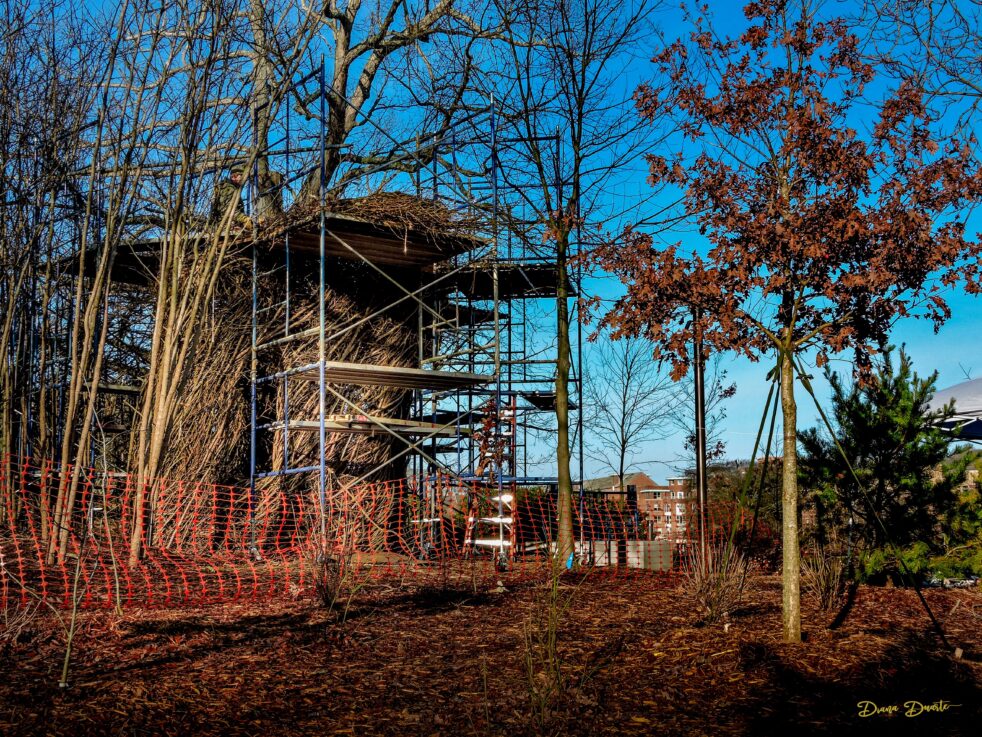Directly to the left of the Kendeda Building for Innovative Sustainable Design, on top of a low hill and framed by oak trees, stands a sculpture made entirely of tree branches and other natural materials woven and bent around each other to form a graceful sculpture that looks like it grew there. The piece is the latest by internationally-acclaimed artist Patrick Dougherty, whose 300+ pieces have appeared all over the world.
Dougherty, who is known for his “stickwork,” describes this piece as an “architectural shrubbery” that reflects structural elements from around Atlanta. When completed, it will be entirely free-standing. The sculpture is visible from Ferst Drive, one of the campus’s main thoroughfares.
Dougherty himself has constructed the piece with a team of volunteers that include Tech students, faculty and staff as well as participants from the Atlanta area. Community installation began Jan. 7 and will wrap up on Jan. 22.
The construction process began with gathering the materials — the sticks themselves — from Serenbe, a New Urbanism community just outside of Atlanta. Once the saplings arrived at the site, Dougherty drilled holes for the largest sticks along the perimeter of the design, following a footprint that he had drafted in advance.
Once the piece has this structural core, the team goes back for an “aesthetic phase”, which Dougherty describes as “using sticks as lines to draw with.”
Finally, they put the finishing touches on the piece in the “fix-up stage.”
Ian Buckalew, a second-year ME student, got involved with the installation over the winter break, when he helped gather materials at Serenbe. When he moved back to campus, he volunteered to assist with building the piece on campus.
“I like the natural vibe he’s going for,” said Buckalew, who describes himself as an outdoorsy person, “You don’t see much wilderness in Atlanta.”
Amy Senn, herself a nature artist, volunteered to assist with the project at the recommendation of a friend. She has followed Dougherty’s work for a few years.
“It’s a really cool opportunity to experience nature in a very unexpected way,” said Senn, “like you’re not going to expect to find this natural architectural structure in the middle of a college campus, so to happen upon it and be able to interact with it is pretty special.”
Dougherty’s installation on Georgia Tech’s campus is part of the Eco-Commons reclamation project to establish 80 acres of greenspace across campus, and will be the first section of the Eco-Commons to open.
Sponsored by the Kendeda Foundation and in partnership with Serenbe and Georgia Tech Arts, Dougherty’s work reflects Tech’s larger commitment to sustainability.
“Patrick’s art sits at the intersection of creativity, environmental sustainability and collaborative work,” said Aaron Shackelford, director of Georgia Tech Arts.
“All of these are important values for us at Georgia Tech, and I hope the campus and city can join him in creating this remarkable and unique new addition to our home.”
“A good sculpture,” said Dougherty himself, “is one that causes people to have a lot of personal associations.”
His goal for the piece is not to make an environmental statement as much as it is to remind people of the importance of nature and to build those positive associations with the environment.
“Anything that moves in the vein of capturing your imagination and is also a bit natural tends to further that end…reminding people of sustainability, environment, ecology,” Dougherty said.
“You kind of need to be able to go look at a tree once in a while.”
Dougherty’s sculpture near the Kendeda building located on Ferst Drive near West Campus, is still under construction and will not be open to the general public until April 2021.
